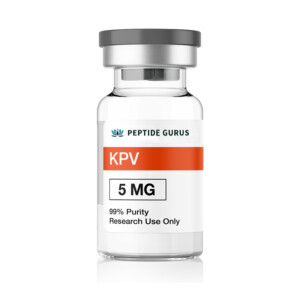KPV peptide, also known as Lysine-Proline-Valine peptide, has emerged as a significant player in the field of wound healing, with its unique properties and potential to enhance the body’s natural repair processes. This article delves into the details of KPV peptide, its wound healing mechanism, and relevant information in line with the latest FDA guidelines.
What is KPV peptide?
KPV peptide is a short-chain peptide composed of the amino acids lysine, proline, and valine. It is a bioactive peptide that has been studied for its beneficial effects on various physiological processes, particularly wound healing. Structurally simple yet functionally powerful, KPV peptide interacts with the body’s cells and signaling pathways to promote tissue repair.
FDA’s stance on peptides for wound healing
The FDA has been closely monitoring the development and use of peptides, including KPV peptide, for wound healing applications. While there are strict guidelines in place to ensure safety and efficacy, research on KPV peptide has shown promising results. The FDA’s approval process for peptide-based wound healing products typically involves rigorous clinical trials to assess factors such as the peptide’s ability to accelerate wound closure, reduce scarring, and minimize the risk of infection. As of now, while KPV peptide may not have an over – the – counter FDA approval for all wound – healing uses, ongoing research is paving the way for potential future approvals in specific indications.
Wound healing mechanism
Anti – inflammatory effect
In the initial stages of wound healing, inflammation is a natural response. However, excessive or prolonged inflammation can impede the healing process. KPV peptide has been found to modulate the inflammatory response. It interacts with immune cells, such as macrophages, which play a crucial role in the inflammatory phase of wound healing. By binding to specific receptors on macrophages, KPV peptide can reduce the production of pro – inflammatory cytokines. For example, it can decrease the release of tumor necrosis factor – alpha (TNF – α) and interleukin – 6 (IL – 6), which are known to cause inflammation. This anti – inflammatory action helps to create a more favorable environment for the subsequent stages of wound healing, such as cell proliferation and tissue remodeling.
Promotion of cell migration and proliferation
For a wound to heal properly, cells need to migrate to the wound site and proliferate to fill in the damaged area. KPV peptide has been shown to stimulate the migration of fibroblasts, which are key cells in the production of collagen, a major component of the extracellular matrix. Fibroblasts move towards the wound area in response to signals from KPV peptide. Additionally, KPV peptide promotes the proliferation of endothelial cells, which are essential for the formation of new blood vessels (angiogenesis). New blood vessels are necessary to supply oxygen and nutrients to the healing tissue. Through these actions, KPV peptide accelerates the process of tissue repair and wound closure.
Extracellular matrix remodeling
The extracellular matrix provides structural support to cells and tissues. During wound healing, the extracellular matrix needs to be remodeled to restore the normal tissue architecture. KPV peptide influences the production and organization of collagen fibers in the extracellular matrix. It can enhance the synthesis of collagen types I and III, which are important for the strength and integrity of the healed tissue. By promoting proper collagen deposition and cross – linking, KPV peptide helps to ensure that the scar tissue formed is strong and functional, reducing the likelihood of abnormal scarring.
Clinical evidence of wound healing
Although not as extensively studied as some other wound – healing agents in large – scale human clinical trials, there are pre – clinical studies and some small – scale clinical observations that suggest the effectiveness of KPV peptide in wound healing. In animal models,
KPV peptide has been shown to accelerate the closure of both acute and chronic wounds. For example, in studies on diabetic mice with impaired wound – healing ability, topical application of KPV peptide led to faster wound closure compared to the control group. In some small – scale human trials involving patients with minor skin wounds, the use of KPV peptide – containing formulations also showed positive trends in terms of reduced healing time and improved scar quality.
Frequently Asked Questions
Q: Is KPV peptide safe for use on all types of wounds?
A: While KPV peptide shows promise in wound healing, it’s not necessarily safe for all types of wounds. Deep, infected, or large wounds should be treated under the supervision of a healthcare professional. The FDA has not approved KPV peptide for all wound – care applications. For minor cuts, scrapes, and certain non – infected wounds, it may be considered, but it’s important to follow the product instructions carefully.
Q: How should KPV peptide be applied for wound healing?
A: KPV peptide is often formulated in creams, gels, or ointments for topical application. When applying, clean the wound gently first. Then, apply a thin layer of the KPV – containing product over the wound. Avoid rubbing the wound vigorously. The frequency of application may vary depending on the product, but generally, it can be applied once or twice a day. However, always consult the product label or a healthcare provider for specific instructions.
Q: How long does it take to see results when using KPV peptide for wound healing?
A: The time to see results can vary. In some cases, for minor wounds, you may start to notice a reduction in redness and an improvement in the appearance of the wound within a few days. However, for larger or more complex wounds, it may take weeks for significant wound closure and healing to occur. Factors such as the size and depth of the wound, the individual’s overall health, and proper wound care also play a role in the healing time.
